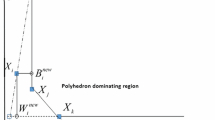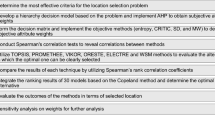Abstract
This paper presents an application of the UTA method for building utility functions for the evaluation criteria defined by the Staff Evaluation Commission (CAD) of the Rio de Janeiro Federal University (UFRJ). Every year, the CAD-UFRJ gives the staff evaluation results for each Postgraduate Engineering Programme. However, the method used to generate the staff evaluation is assumed unknown. Trying to find the CAD-UFRJ preference structure, the evaluation results supplied by CAD-UFRJ are used to apply the UTA method. Some additional information obtained from the CAD-UFRJ data is incorporated in the optimal solutions analysis.
Similar content being viewed by others
References
C.A. Bana e Costa, Readings in Multiple Criteria Decision Aid (Springer, Berlin, 1990).
C.A. Bana e Costa and J.C. Vansnick, MACBETH-An interactive path towards the construction of cardinal value functions, International Transactions in Operations Research 1 (1994) 489-500.
V. Belton and S. Vickers, Use of a simple multi-attribute value function incorporating visual interactive sensitivity analysis for multiple criteria decision making, in: Readings in Multiple Criteria Decision Aid, ed. C.A. Bana e Costa (Springer, Berlin, 1990).
M. Beuthe and G. Scannella, Comparative analysis of UTA multicriteria methods, in: International Conference on Methods and Applications of Multicriteria Decision Making, FUCAM-Facultés Universitaires Catholiques de Mons, Belgium (1997).
J.P. Brans and P.A. Vincke, Preference ranking organisation method (The PROMETHEE method for multiple criteria decision-making), Management Science 31 (1985) 647-656.
W. Edwards, Social utilities, Engineering Economist, Summer Symposium Series 6 (1971).
L.F.A.M. Gomes, C.F.S. Gomes and A.T. De Almeida, Managerial Decision Making-A Multicriterion Focus (Atlas, Rio de Janeiro, 2000) (in Portuguese).
E. Jacquet-Lagreze and J. Siskos, Assessing a set of additive utility functions for multi-criteria decision-making, the UTA method, European Journal of Operational Research 10 (1982) 151-164.
R.L. Keeney and H. Raiffa, Decisions with Multiple Objectives: Preferences and Value Tradeoffs (Wiley, New York, 1976).
L.A.D. Rangel and L.F.A.M. Gomes, A UTA method utilization to determine the evaluation criteria utility functions of conveyor belts standardization alternatives, in: Annals of XXXII SBPO-Brazilian Symposium of Operational Research, Brazil (2000) (in Portuguese).
L.A.D. Rangel and L.F.A.M.Gomes, Evaluation of Volta Redonda Production engineering candidates, UFF: A multicriteria framework, in: Annals of XXXIII SBPO-Brazilian Symposium of Operational Research, Brazil (2001) (in Portuguese).
B. Roy, Ranking and choice in presence of multiple points of view (the ELECTRE method), RIRO 8 (1968) 57-75 (in French).
T.L. Saaty, the Analytic Hierachy Process (McGraw-Hill, New York, 1980).
J. Siskos and D. Yannacopoulos, UTASTAR: An ordinal regression method for building additive value functions, Investigação Operacional 5 (1985) 39-53.
Y. Siskos, C. Zopounidis and A. Pouliezos, An integrated DSS for financing firms by an industrial development bank in Greece, Decision Support System 12 (1994) 151-168.
Staff Evaluation Commission, Regulations of staff evaluation commission, COPPE/UFRJ, Brazil (1997) (in Portuguese).
Staff Evaluation Commission, Presentation of CAD evaluation results 98/99, COPPE/UFRJ, Brazil (1999) (in Portuguese).
R.E. Steuer, Manual for the ADBASE, multiple objective linear programming package, Faculty of Management Science, University of Georgia, Athens, GA (1994).
T.J. Stewart, Pruning of decision alternatives in multiple criteria decision making, based on the UTA method for estimating utilities, European Journal of Operational Research 28 (1987) 79-88.
C. Zopounidis and A.I. Dimitris, Multicriteria Decision Aid Methods for the Predictions of Business Failure (Kluwer, Amsterdam, 1998).
Author information
Authors and Affiliations
Rights and permissions
About this article
Cite this article
González-Araya, M.C., Rangel, L.A.D., Lins, M.P.E. et al. Building the Additive Utility Functions for CAD-UFRJ Evaluation Staff Criteria. Annals of Operations Research 116, 271–288 (2002). https://doi.org/10.1023/A:1021396717667
Issue Date:
DOI: https://doi.org/10.1023/A:1021396717667




